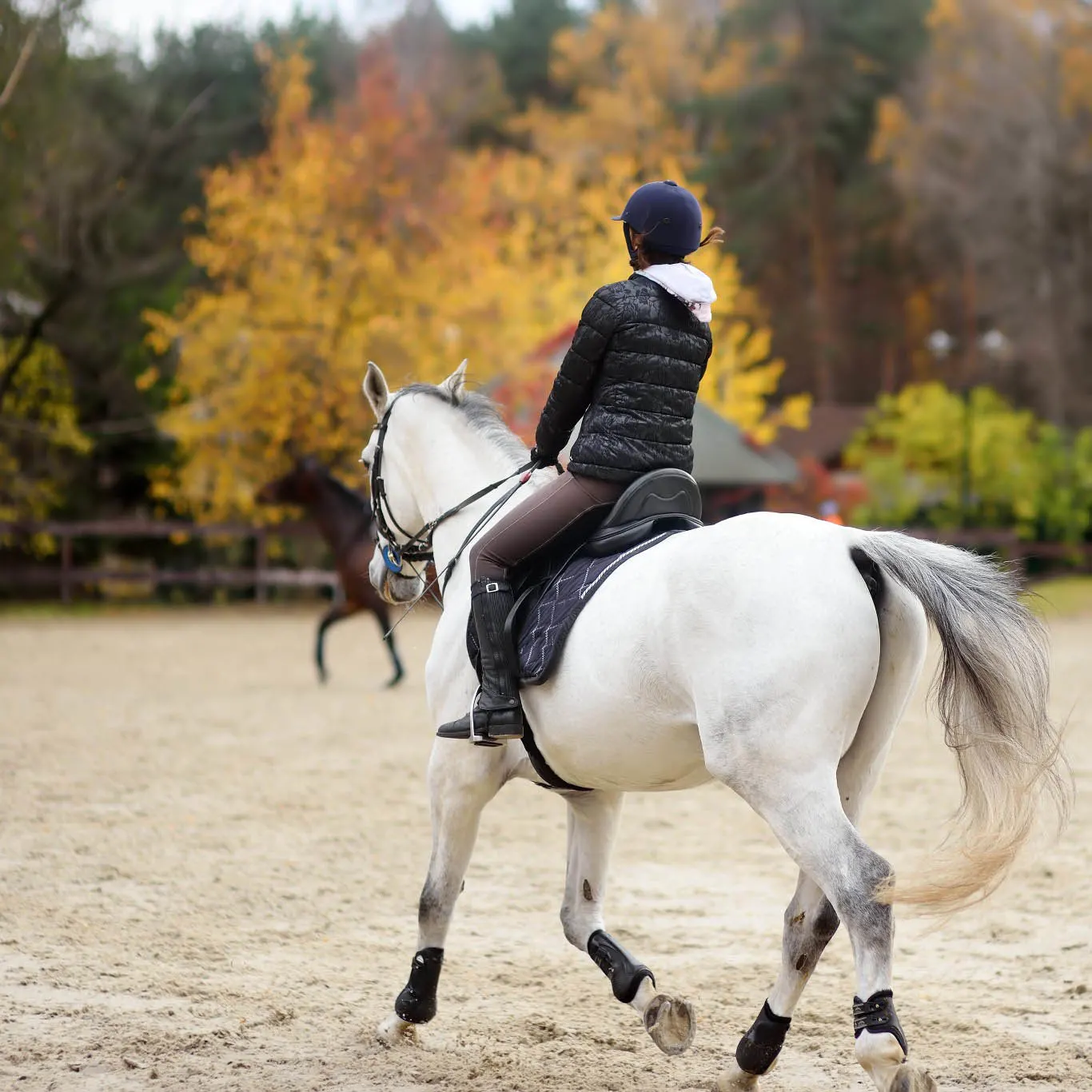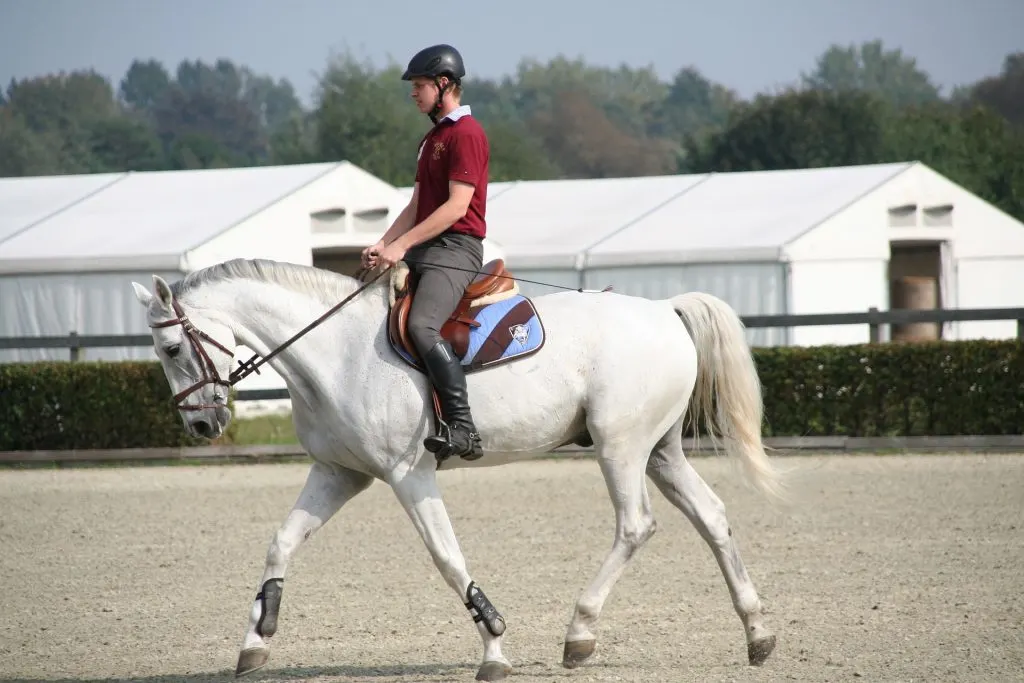White mares are beautiful horses, with long white manes and bodies that shimmer in the moonlight.
Because of this, they’ve reached something of a mythological status – often appearing in the folklore of various cultures, fantasy genre movies, and even appearing in the Harry Potter world as a type of Patronus.
In this article, you’ll learn more about white mares, including:
- their significance in folklore and why white horses are actually associted with “good guys” in media
- exactly how rare white mares are and why you should never set out to try and buy a white mare.
- my experience owning one of these beautiful horses, and a few tips on keeping a white horse clean.

Why White Mares Aren’t Actually White
Some very literal thinking equestrians will insist that there is no such thing as a white mare- and in fact, they’re technically correct. Mares that appear to be white are actually either albino (lacking all pigment), grey horses (carrying a particular gene that causes melanin in fur to depigment completely), or perhaps a very pale palomino horse.
Even though “white” horses might not exist in the genetic sense, the reality is that the human eye perceives white horses relatively often – especially in film and television, where white horses are particularly prized. So while analytical thinkers may insist a white mare doesn’t exist, perception gives us cause to debate this point!
White Mares In Books, Movies, & Folklore
I believe white mares have taken a role in folklore as mythical creatures for a few reasons: their rarity, their femininity, and their unique appearance.
White mares often appear in cultural folklore
In many myths, white horses appear as divine, otherworldly creatures. In some cultures, they are associated with femininity, purity, and innocence. Alternately, in other cultures (especially tose, like india, where white is associated with loss and grief) white horses may be associated with death and the underworld. In many folktales and legends, the white mare is a mystical creature who possesses power and wisdom.
I think the femininity of mares has also contributed to mares that are white becoming a part of fantasy genres in film and literature. Whether accurate or not, we project a lot of human womanly wisdom onto mares, who are sometimes temperamental but also bond deeply with their handlers and sense danger perhaps more acutely and accurately than geldings.
White mares in media
Hollywood loves a grey or white horse- they’re easy to photograph! White mares are often chosen for horse shows and parades. One reason is that white mares are very rare- this makes them special, which is something that parades and exhibition horse shows are all about. For parade saddles decked in silver, white coats can take on a metallic sheen that matches the ornate parade saddles and bridles. Finally, white mares have a regal look about them that is perfect for horse shows and parades.
White White horses are actually associated with “the good guy”
If you were to walk into my pasture late at night, your eye would immediately land on my white mare. While the rest of the horses disappear into the darkness, even the faintest light from a sliver of a crescent moon hitting a white mare’s coat reflects brightly. When the whole world is cloaked in darkness, my white mare is clearly visible. The white coat reflects and forms a sort of shimmering figure in the darkness.
It didn’t take too many nighttime checks on my herd to realize why white mares have a sort of mythical status and folklore!
Did You Know?
The reason that we associate white horses with “the good guys” and dark horses with “the bad guys” is based on the science of light. After dark, bay, brown, and black horses seem to disappear into the night. However, white or light grey fur reflects even faint light, making it easier for white horses to be seen at night.

White Mares Are Special Because They Are Rare
White mares are rare in the horse world. To fit the definition, a horse must have three qualifications:
- Carry the grey horse gene that causes horses to turn white (about 10% of horses have this gene)
- Be a female (about 50% of horses)
- Be old enough for the grey gene’s depigmentation process to have resulted in a white coat- usually, a minimum of 5 years old. (very roughly estimated, about 50% of living horses might be over five years old.)
If you go off these calculations, that means that white mares make up no more than 2.5% of horses. In a horse show with 100 horses entered, perhaps only one or two of those horses would be a white female horse.
Did you know? White mares make up no more than 2.5% of horses.
My Experience Owning a White Mare
Although my first horse was a dapple gray gelding, the second horse I ever owned was a white mare ironically named “Ebony”. Her name – which was even included on her Bashkir Curly registration papers and always raised eyebrows at horse shows and veterinary appointments- is a clue to how the color of grey/white horses’ fur changes over a horse’s lifespan.

Why you Should Never Try to Buy a White Mare
Almost any horse person can tell you, shopping for a horse based on the color is usually an exercise that ends in frustration and futility.
An old saying about horses goes something like “a good horse is never a bad color” – in other words, shop for the horse’s training, temperament, breeding, confirmation, and health first and then and only then consider color in your decision of whether or not to buy a particular horse. For ideas for questions to ask before buying a horse click here.
There are a lot of things to consider before buying a horse, (here’s my guide for first time buyers) and the color of the horse should be far down on that list. A horse’s coat doesn’t impact how much fun you’ll hae riding, so it’s not worth basing your decision on something that’s so superficial. Instead, focus on things like the mare’s health, temperament, and training.
A well trained mare is more fun to ride than an untrained one. She is more responsive to your commands and is less likely to get spooked or act up. She will also be more comfortable to ride, since she will know what is expected of her- what color she is matters very little to your day to day expereince in lessons, trails, and horse shows.
Caring For A White Mare
In general, these mares require the same care and maintenance that any other color or gender of horse requires. The challenge with white mares is keeping their white coats bright and clean. Just like wearing white riding pants to a horse show, they are really hard to keep clean!
For tips on some special techniques I use to keep my white and gray horses clean day-to-day, and special grooming tips for horse show preparation and bathing, follow the links provided.
Based on my expereince owning a white mare, here are a few tips for how to groom a white horse to keep their coat bright:
- First, give your horse a good bath. You can use a special horse shampoo that is designed to brighten white coats or add a tiny bit of laundry bluing to some human shampoo (they’re the same pH!). Be sure to rinse your horse thoroughly after soaping.
- Let your horse dry completely. If it’s cold outside, you’ll need to use a horse cooler until their coat is dry enough to keep them warm.
- Once the coat is clean and conditioned, you can use a thin sheet (even a fly sheet) to help crete a barrier between your horse’s clean fur and the dirt in stalls and pastures. While you can’t cover your horse all the time, this is helpful to be sure your just-bathed white horse doesn’t have manure stains when you wake up on show morning!
- Finally, you can use a shine spray or serum to help give the mare’s coat a nice, healthy shine.
